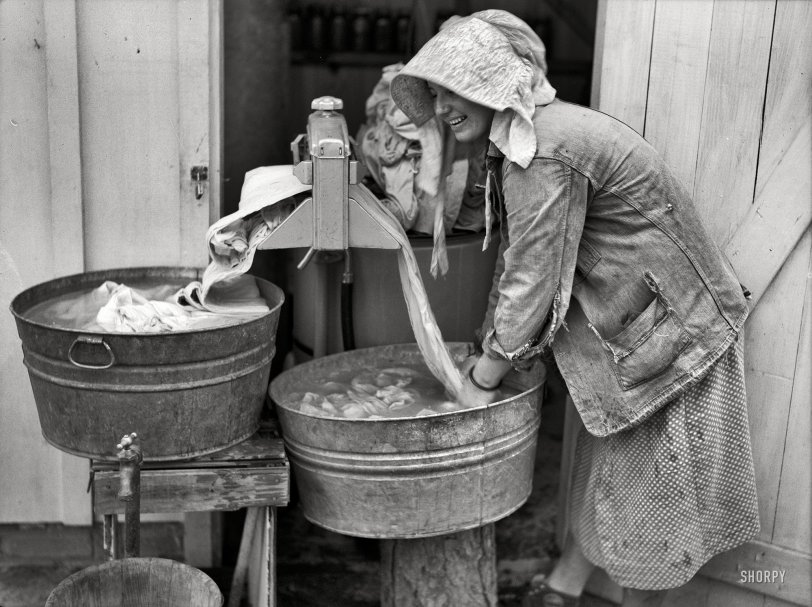


Framed or unframed, desk size to sofa size, printed by us in Arizona and Alabama since 2007. Explore now.
Shorpy is funded by you. Patreon contributors get an ad-free experience.
Learn more.

- Freeze Frame
- Texas Flyer wanted
- Just a Year Too Soon
- WWII -- Replacing men with women at the railroad crossing.
- Yes, Icing
- You kids drive me nuts!
- NOT An Easy Job
- I wonder
- Just add window boxes
- Icing Platform?
- Indiana Harbor Belt abides
- Freezing haze
- Corrections (for those who care)
- C&NW at Nelson
- Fallen Flags
- A dangerous job made worse
- Water Stop
- Passenger trains have right of way over freights?
- Coal
- Never ceases to amaze me.
- Still chuggin' (in model form)
- Great shot
- Westerly Breeze
- For the men, a trapeze
- Tickled
- Sense of loneliness ...
- 2 cents
- Charm City
- What an Outrage
- Brighton Park
Print Emporium
Through the Wringer: 1938

May 1938. Irwinville Farms, Georgia. "Mrs. Coleman doing a washing." Slow but steady progress in the science of mechanized laundry. Medium-format nitrate negative by John Vachon for the Resettlement Administration. View full size.
Jealous of Mrs. Coleman's water faucet.
At least Mrs. Coleman didn't have to draw all that water out of a well, bucket by bucket, like we did. Also, there had to be a fire built in the yard to heat the water. Wash the clothes in the washer, wring out and into the first tub of rinse water, wring out again and into the secont tub of rinse water. I hated washday until I was sixteen!
The Wringer Washer
Our Mother had a wringer washer well into the 1940s. An Easy. Here's the drill: Fill washer with hot water and soap. Add dirty clothes. Let washer agitate for how many minutes you need. Drain washer into laundry sink. Run soapy clothes through wringer, place back in washer. Fill washer with clean water, agitate again. Drain washer, and wring clothes again. Shake out each piece and hang on clothesline. A lot of work, but it sure beats a scrub board.
Work saver
I have done laundry by hand a few times and the hardest thing about it, by farm was wringing enough water out by hand so that things could dry before bacteria would start to grow in them. I've also used an old wringer washer, and the wringer made an enormous difference! I'll bet Mrs. Coleman had done plenty of laundry by hand and was very thankful for that electric wringer!
Don't Waste the Effluent
Actually that was why it was banned in the 1970s and later. The phosphates got into the sewer water and eventually into the ground water. In rivers and (locally) the Great Lakes, it led to algae blooms that killed off fish and damaged the quality of the drinking water.
Just a non-scientific poll
I wish I could know how many of us Shorpy viewers couldn't resist smiling back at this lady smiling at us. What a nice way to start my day.
Is she wearing
Why not? They were generally considered "po' folk" shoes back during the Depression. I think that Chuck Taylor designed them during the 1920s.
Pre-wash perhaps?
I see what looks to be a portable washer on the other end of that wringer actually driving the rollers. She is probably either pre washing the sheets or just doing them by hand to save electricity. Use it up, wear it out, make do or do without. They were a necessarily frugal bunch back then, and would be dismayed, I think, at the waste and profligate abuse of resources occurring today. But I still wouldn't trade places with them.
Laundry is so easy
I do other things while the clothes are washing but I remember one of these machines in the basement as late as 1967. BTW, I think this photo needs a "pretty girls" tag with that lovely face and smile.
Don't Waste the Effluent
Old-timers have told me that the phosphates in the old laundry soaps made the waste water useful as fertilizer.
Wringers
My grandmother used one of those into the mid 1970s. She had it on the back porch between two sinks just like that. She was a child of the depression and there was no reason to spend money on new-fangled washing machines when the old wringer worked fine. Hers was electric if I recall.
Not Just Another Pretty Face
Everything in this picture conveys a hard life and then there's that pretty, smiling face. Her expression changes the whole picture.
Wringer use
I thought the wringer was used for removing water from your clothes. Yet both her buckets are full, and the presumably clean laundry is headed into a full bucket of water? Am confused.
[She's wringing out the soapy water. - Dave]
























On Shorpy:
Today’s Top 5